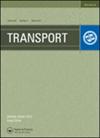山区公路发夹弯道驾驶员心理负荷试验研究
IF 1.3
4区 工程技术
Q3 TRANSPORTATION SCIENCE & TECHNOLOGY
引用次数: 0
摘要
为了揭示驾驶员在发夹曲线段下的驾驶心理特征及其影响因素,选取11条连续山路发夹曲线进行自然驾驶试验,并利用车载仪器采集驾驶员在自然驾驶习惯下的心电图。分析驾驶员的整体心率特征、心率增加(heart rate Increase, HRI)、心率变异性(heart rate Variability, HRV)特征,以及心率变化与弯角、斜坡和弯道环境视觉表现的关系。并与一般曲线进行比较。结果表明:以180°为极限,发夹曲线的曲线角度可分为较大、较小和近似3种类型。三种弯道角度对驾驶员心率波动的影响不同。整体心率分布可分为2个区域,其中曲线角度≈180°的曲线处,每位驾驶员的平均心率高于其他2种曲线。曲线中间的心率整体波动幅度在3段曲线区域处于最低水平。通过HRI特征值分析可以看出,驾驶员在下坡时更容易受到外部环境的影响。上坡时,心率异常值分布范围稳定,但突变明显。而在下坡方向上,整体相邻心率变化较大,但突变较小。以曲线段HRI变化趋势为指标,将心率类型分为持续紧张型、逐渐放松型、松弛-紧张型、紧张-松弛型4类。这4种模式与弯道入口环境的差异有显著的关系。与一般曲线所显示的模式相比,它们侧重于波动较大的模式,而一般曲线侧重于更单一的增长趋势。本文章由计算机程序翻译,如有差异,请以英文原文为准。
EXPERIMENTAL STUDY ON DRIVER’S MENTAL LOAD IN HAIRPIN CURVES OF MOUNTAINOUS HIGHWAY
In order to reveal the driving psychological characteristics and influencing factors of drivers under the hairpin curve section, 11 continuous hairpin curves on mountain roads were selected for natural driving test, and the on-board instruments were used to collect the driver’s ElectroCardioGraphy (ECG) under the natural driving habits. Analyse the overall heart rate characteristics, Heart Rate Increase (HRI), Heart Rate Variability (HRV) characteristics of drivers, as well as the relationship between heart rate change and the visual performance of curve corner and slop and curve environment. And compared with the general curve. The results show that: with 180° as the limit, the curve angle of the hairpin curve was divided into 3 types: greater, less or approximate. The 3 types of curve angle have different effects on the driver’s heart rate fluctuations. The overall heart rate distribution can be divided into 2 regions, in which the average heart rate of each driver at the curve, which curve angle ≈ 180°, was higher than the other 2 types of curves. The overall fluctuation range of heart rate in the middle of the curve is at the lowest level in the 3-stage curve segment area. Through the eigenvalue analysis of HRI, it can be seen that the drivers were more susceptible to the external environment when going downhill. When going uphill, the distribution range of the heart rate abnormality value was stable, but the sudden change was obvious. However, during the downhill direction, the overall adjacent heart rate varies greatly, but the abrupt change was small. Take the change trend of the HRI in the curve segment as an indicator, heart rate types were divided into 4 categories, continuous tension, relax gradually, relaxation-tension, and tension-relaxation. The 4 modes have a significant relationship with the difference of curve entrance environment. Compared with the modes shown in general curves, they focus on the modes with greater volatility, while the general curves focus on a more single growth trend.
求助全文
通过发布文献求助,成功后即可免费获取论文全文。
去求助
来源期刊

Transport
Engineering-Mechanical Engineering
CiteScore
3.40
自引率
5.90%
发文量
19
审稿时长
4 months
期刊介绍:
At present, transport is one of the key branches playing a crucial role in the development of economy. Reliable and properly organized transport services are required for a professional performance of industry, construction and agriculture. The public mood and efficiency of work also largely depend on the valuable functions of a carefully chosen transport system. A steady increase in transportation is accompanied by growing demands for a higher quality of transport services and optimum efficiency of transport performance. Currently, joint efforts taken by the transport experts and governing institutions of the country are required to develop and enhance the performance of the national transport system conducting theoretical and empirical research.
TRANSPORT is an international peer-reviewed journal covering main aspects of transport and providing a source of information for the engineer and the applied scientist.
The journal TRANSPORT publishes articles in the fields of:
transport policy;
fundamentals of the transport system;
technology for carrying passengers and freight using road, railway, inland waterways, sea and air transport;
technology for multimodal transportation and logistics;
loading technology;
roads, railways;
airports, ports, transport terminals;
traffic safety and environment protection;
design, manufacture and exploitation of motor vehicles;
pipeline transport;
transport energetics;
fuels, lubricants and maintenance materials;
teamwork of customs and transport;
transport information technologies;
transport economics and management;
transport standards;
transport educology and history, etc.
 求助内容:
求助内容: 应助结果提醒方式:
应助结果提醒方式:


